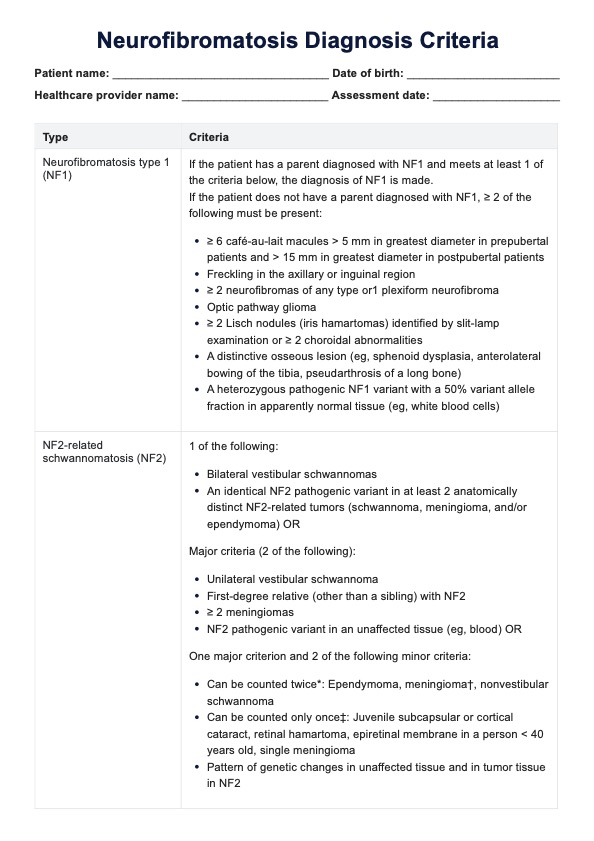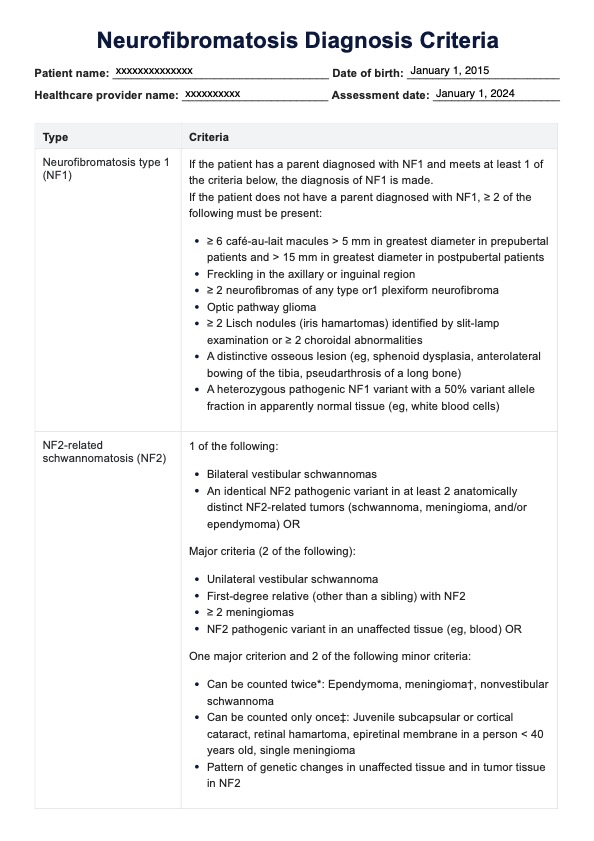Neurofibromatosis Diagnosis Criteria
Accurately diagnose your patient with neurofibromatosis with the help of our Neurofibromatosis Diagnosis Criteria template.


What is neurofibromatosis?
Neurofibromatosis (NF) represents a group of genetic and neurological disorders that affect tissues of nerve cells and impact the brain, spinal cord, and skin. There are three types of neurofibromatosis, and here’s an overview of the three of them:
- Neurofibromatosis type 1 (NF1): The most prevalent form of NF that follows an autosomal dominant inheritance pattern, NF1 is caused by mutations of the NF1 gene located on chromosome 17. This chromosome produces a protein called neurofibromin that suppresses tumors, causing neurofibromin loss and uncontrolled cell growth of nerve tissue.
- Neurofibromatosis type 2 (NF2): This type is usually caused by a faulty gene that may have been passed on from a parent to a child or a spontaneous gene mutation, causing slow-growing, uncontrolled nerve tumors.
- Schwannomatosis (SWN): The rarest form of NF, schwannomatosis is caused by changes in the SMARCB1 or LZTR1 genes, which prevent cells from forming tumors.
Signs and symptoms of neurofibromatosis
Neurofibromatosis manifests with a variety of symptoms, which vary depending on the specific type of the disorder. Here’s an overview of the typical symptoms one may have based on the type of NF:
- NF1: Café au lait spots or coffee-colored patches, freckles in the armpits or groin, tumors on the optic nerve, bone deformities, lisch nodules, high blood pressure, and learning and behavioral problems. These symptoms often appear in early childhood.
- NF2: Benign tumors, hearing loss, vision loss/changes, dizziness, issues with balance, and tumors on peripheral nerves causing peripheral neuropathy. These symptoms may appear during childhood, adolescence, or early adulthood.
- SWN: Pressure on spinal nerve roots and numbness, weakness, headaches, lumps/swollen areas where the tumors are located
Do note that there are cases wherein the patient may not experience all of the symptoms of NF1.
Neurofibromatosis Diagnosis Criteria Template
Neurofibromatosis Diagnosis Criteria Example
Diagnosing neurofibromatosis
Diagnosing neurofibromatosis involves a comprehensive approach that includes the following:
Medical history and physical examination
A healthcare professional must review the patient's personal and family medical history, paying particular attention to relatives who may have been diagnosed with NF. During the physical exam, the physician will also examine the hallmark signs and symptoms of NF.
Conduct imaging tests
Physicians must perform imaging tests such as X-rays, CT scans, or MRIs since they play a crucial role in the diagnostic process. They are used to identify bone abnormalities, brain or spinal cord tumors, and very small tumors that might not be evident during a physical examination.
Genetic testing
Aside from medical history, family history, physical examination, and imaging tests, a healthcare professional must confirm the presence of mutation associated with the disorder, which can also be performed prenatally to assess the risk for the unborn child.
Neurofibromatosis Diagnosis Criteria
During the processes mentioned above, it'd be helpful if healthcare professionals refer to the Neurofibromatosis Diagnosis Criteria provided in this guide to evaluate if the results pertain to NF. The criteria can also be useful as the clinician conducts a differential diagnosis.
Please note that patients may be further subjected to other diagnostic evaluations, such as blood tests, to aid or confirm diagnosis.
Next steps after diagnosis
After diagnosing NF, several important steps should be considered to manage the challenging condition effectively:
- Regular monitoring: Clinicians must regularly conduct imaging tests to track tumor growth in the nervous system and assess any changes over time so that any progression can be promptly addressed.
- Prescribe medication: For certain cases, depending on the type and location of the tumor, medication like selmetinib, which can shrink tumor size, and clinical trials for similar medication may be potential alternative treatments for managing NF effectively.
- Surgical intervention: If the fibromatosis is causing severe symptoms or is compressing nearby tissues or organs, surgical removal of the tumor may be needed to relieve symptoms by partially or completely eliminating the tumor mass. In cases of schwannomatosis, about one-third of individuals have tumors limited to a single part of the body, such as an arm, leg, or a segment of the spine.
- Standard cancer treatments: Standard cancer treatments may be employed for cancerous tumors.
Benefits of using the Neurofibromatosis Diagnosis Criteria
The establishment of diagnostic criteria templates for neurofibromatosis offers several significant benefits. Here are some of them:
- Facilitates early detection and intervention: With a diagnosis criteria template, healthcare practitioners can make a more accurate and timely diagnosis, allowing them to monitor the condition closely and intervene when necessary immediately. This aids in better managing symptoms and preventing complications.
- Provides framework: Healthcare professionals who use the template have a framework for when and how to utilize genetic testing since the criteria identify the specific genes responsible for the different NF types. This is invaluable for making informed medical and lifestyle decisions.
- Aid in the distinct classification of SWN: Using the template can help healthcare providers better distinguish schwannomatosis from other forms of NF. This makes it crucial to tailor their approach to diagnosis and treatment based on the conditions' unique characteristics.
Commonly asked questions
Those who don't have complications and are diagnosed and treated early on are expected to have an almost normal life expectancy.
The hallmark symptom of neurofibromatosis is the appearance of "coffee-with-milk" (café au lait) spots on the skin. Many healthy people have one or two small café au lait spots, but adults with six or more spots larger than 1.5 cm (0.5 cm in children) could have neurofibromatosis.
Those who are diagnosed with NF1 have an increased risk of having other forms of cancer, such as breast cancer and brain tumors. Aside from that, they may also develop a benign adrenal gland tumor that may not be cancerous but may still negatively affect one's health.







































































































